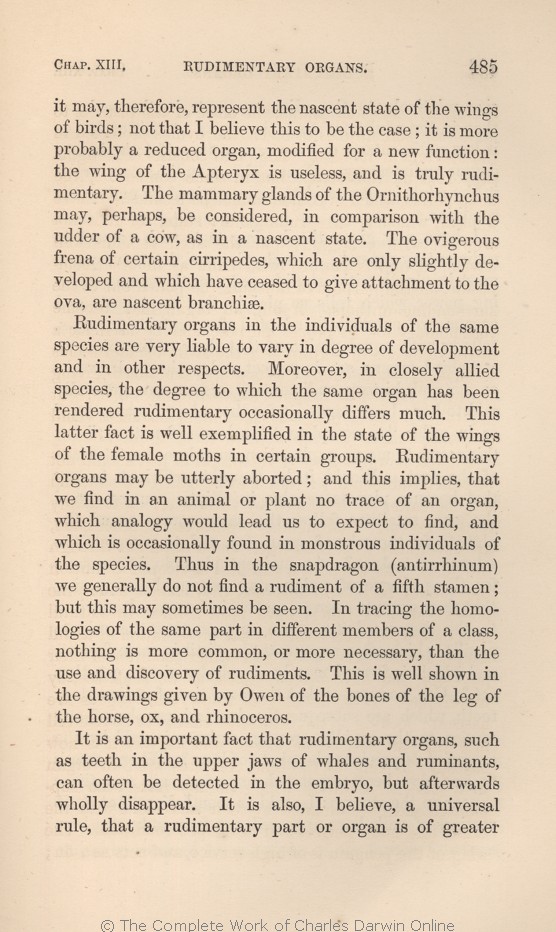it may, therefore, represent the nascent state of the
wings | wings 1860 1861 | | wing; 1866 1869 1872 |
| of birds; 1860 1861 | of birds; 1866 1869 1872 |
| case; 1861 1866 1869 1872 | | case, 1860 |
| function: 1860 1861 1866 1869 | | function; 1872 |
| Apteryx 1860 1861 | | Apteryx, 1866 1869 1872 |
| is 1860 1861 |
| on the other hand, is quite 1866 1869 1872 |
| 1 blocks not present in 1859 1860 1861 1872; present in 1866 1869 | | The simple filamentary limbs of the Lepidosiren apparently are in a nascent state; for, as Owen has remarked,
they are the "beginnings of organs which attain full functional development in higher vertebrates."
|
| glands 1860 1861 1866 1869 | | glans 1872 |
| Ornithorhynchus 1860 1861 1866 1872 | | Ornitho-rhynchus 1869 |
| may, 1860 1861 1866 | | may 1869 1872 |
| perhaps, 1860 1861 | | probably, 1866 | perhaps, 1869 1872 |
| the udder of a 1860 1861 |
| those of the 1866 |
| the udders of a 1869 1872 |
| state. 1860 1861 | | condition. 1866 1869 1872 |
| are only slightly developed and which 1860 1861 1866 1869 |
| OMIT 1872 |
| ova, 1860 1861 1866 1869 | | ova 1872 |
| are 1860 1861 1866 1869 |
| and are feebly developed, are 1872 |
| in the individuals of the same species 1860 1861 1866 1872 |
| OMIT 1869 |
| degree of 1860 1861 1866 |
| the degree of their 1872 |
| OMIT 1869 |
| respects. 1860 1861 1866 1872 |
| respects in the individuals of the same species. 1869 |
| Moreover, in 1860 1861 1866 1869 | | In 1872 |
| the degree 1860 1861 1866 1869 |
| also, the extent 1872 |
| rendered rudimentary 1860 1861 1866 | | reduced 1869 1872 |
| of the 1859 1860 1861 | | of 1866 1872 | | in 1869 |
| in certain groups. 1859 1860 1861 1866 1869 |
| belonging to the same family. 1872 |
| we find in an 1859 1860 1861 1866 |
| in certain 1869 1872 |
| animal 1859 1860 1861 1866 | | animals 1869 1872 |
| plant 1859 1860 1861 1866 | | plants, 1869 1872 |
| no trace of an organ, 1859 1860 1861 1866 |
| parts are entirely absent 1869 1872 |
| find, 1859 1860 1861 1866 1869 | | find 1872 |
| and which is 1859 1860 1861 1866 |
| and which are 1869 |
| in them, and which are 1872 |
| individuals 1859 1860 1861 1866 | | individuals. 1869 1872 |
| of 1859 1860 1861 1866 | of 1869 1872 |
| the 1859 1860 1861 1866 | the 1869 1872 |
| species. 1859 1860 1861 1866 | species. 1869 1872 |
| the snapdragon (antirrhinum) we generally do not find a rudiment of a 1859 1860 1861 |
| some Scrophulariaceæ we rarely find even a rudiment of a 1866 |
| most of the Scrophulariaceæ the 1869 1872 |
| stamen; 1859 1860 1861 1866 | | stamen 1869 1872 |
| but this may sometimes 1859 1860 1861 1866 |
| is utterly aborted; yet we may conclude that a fifth stamen once existed, for a rudiment of it is found in many species of the family, and this rudiment occasionally becomes perfectly developed, as may 1869 |
| is utterly aborted; yet we may conclude that a fifth stamen once existed, for a rudiment of it is found in many species of the family, and this rudiment occasionally becomes perfectly developed, as may sometimes 1872 |
| seen. 1859 1860 1861 |
| seen plainly or fully developed. 1866 |
| seen in the common snap-dragon. 1869 1872 |
| the same 1859 1860 1861 1866 | | any 1869 1872 |
| members 1859 1860 1861 1869 1872 | | mem- bers 1866 |
| a 1859 1860 1861 | | the same 1866 1869 1872 |
| or more necessary, 1859 1860 1861 1866 1869 |
| or, in order fully to understand the relations of the parts, more useful 1872 |
| than the use and 1859 1860 1861 1866 |
| in order fully to understand the relations of the parts, than the 1869 |
| than the 1872 |
| bones 1859 1860 1861 1866 1869 | | leg-bones 1872 |
| leg of the 1859 1860 1861 1866 1869 |
| OMIT 1872 |
|
It is an important fact that rudimentary organs, such as teeth in the upper jaws of whales and ruminants, can often be detected in the embryo, but afterwards wholly disappear. It is also, I believe, a universal rule, that a rudimentary part
or organ | or organ 1859 1860 1861 1866 | or organ 1869 1872 |
|









